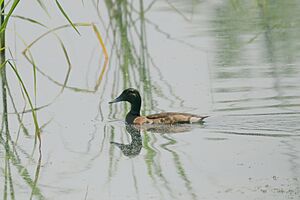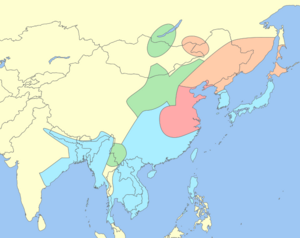Baer's pochard facts for kids
Quick facts for kids Baer's pochard |
|
|---|---|
 |
|
| Male (wintering) | |
 |
|
| Female (breeding) | |
| Conservation status | |
| Scientific classification | |
| Genus: |
Aythya
|
| Species: |
baeri
|
 |
|
| Resident Breeding season Passage Non-breeding season | |
| Synonyms | |
|
List
|
|
The Baer's pochard (Aythya baeri) is a type of diving duck found in eastern Asia. These ducks live all year round in North and Central China. They used to breed in southeast Russia and Northeast China. In winter, they fly south to places like southern China, Vietnam, Japan, and India. The Baer's pochard is a monotypic species, meaning it's the only type in its group.
This duck has a special black head and neck that can look green in good light. In dim light, it might seem completely black. It looks a lot like the ferruginous duck and was once thought to be the same species. However, you can tell the Baer's pochard apart by its white sides when it floats on water. It also has a longer, more rounded head and is bigger.
Baer's pochards build their nests from plants like sedges and reeds. They usually place them in shallow water or on small islands. A female duck lays between 5 and 14 eggs. The male often stands guard while the female takes care of incubating the eggs.
Sadly, the Baer's pochard was once common but is now very rare. There might be fewer than 1,000 adult ducks left, and their numbers are still dropping. Hunting and losing their natural homes are the main reasons for this decline. Because of this, the IUCN has listed it as critically endangered. In China, it is a first-class protected animal.
Contents
What is a Baer's Pochard?
How Was the Baer's Pochard Named?
The Baer's pochard was first described by scientists in 1863. A scientist named Gustav Radde gave it the name Anas baeri. The name "baeri" and its English common name honor another scientist, Karl Ernst von Baer. This duck is also sometimes called the eastern white-eye or green-headed pochard. The first duck studied was found in the middle Amur region during breeding season.
For a while, some scientists thought the Baer's pochard and the ferruginous duck were the same species. But a Chinese scientist, Tso-hsin Cheng, showed they were different. He noticed they bred in different areas and didn't mix. Some scientists also think the Baer's pochard might be more closely related to the hardhead duck.
How Does the Baer's Pochard Look?
The Baer's pochard is about 41 to 47 centimeters (16 to 18.5 inches) long. Its wings can spread 70 to 79 centimeters (27.5 to 31 inches) wide. Males are a bit larger, weighing around 500 to 730 grams (17.6 to 25.7 ounces). Females weigh about 590 to 655 grams (20.8 to 23.1 ounces).
When breeding, the male has a black head and neck with a green shine. Its eyes are white or pale yellow. Its back is brownish-black, and its chest is dark chestnut. The sides are white or light chestnut. The female has brown eyes and a dark brown head and neck. These colors blend into her chestnut-brown chest and sides. Young males look like females but keep their white eyes. Both males and females have wide white patches on their wings. They also have a dark-grey bill with a black tip.
How to Tell it Apart from Similar Ducks?
The Baer's pochard looks similar to its close relative, the ferruginous duck. Both have white undersides and white eyes in males. They also have a black bill tip and wide white wing patches. However, the Baer's pochard is bigger. It has a longer head, body, and bill.
The ferruginous duck has a tall, triangular head. In contrast, the Baer's pochard has a more rounded head and a flatter forehead. The white part on the Baer's pochard's belly extends to its sides, which you can see when it's floating. The ferruginous duck has a smaller white area on its belly. Female Baer's pochards also have a bright chestnut spot near their eyes, which the ferruginous duck lacks.
Baer's pochards are usually quiet ducks. But during their courtship display, both males and females make a harsh "graaaak" sound. Females might also make a "kura kura kura" sound, and males a "kuro kuro" sound at other times.
Where Do Baer's Pochards Live?
Where Do They Breed and Migrate?
Baer's pochards traditionally bred in the Amur and Ussuri river areas. These are in Northeast China and the southeastern Russian Far East. More recently, they have also started breeding in North China and Central China.
In winter, they fly to areas south of the Yellow River in China. They also go to Taiwan, Japan, Bangladesh, India, North Korea, Laos, Myanmar, Nepal, Thailand, and Vietnam. Sometimes, they are seen in Bhutan, South Korea, Philippines, or Pakistan, but this is rare. They leave their winter homes by mid-March and return by mid-October or early November.
Changes in Their Home Range
This species has become very rare in its old breeding areas. Since 2010, there have been no confirmed reports of them breeding north of Beijing. However, fewer ducks are counted in summer than in winter. This means there might still be unknown breeding spots. For example, there are some possible breeding reports in parts of Lake Khanka and Lake Khasan.
Since 2012, new breeding sites have been found in Chinese provinces like Hebei, Hubei, and Jiangxi. These new areas are far from their traditional homes. Warmer weather in these new spots means a longer breeding season. This allows the ducks to lay new eggs if their first batch doesn't hatch. In central and eastern China, Baer's pochards no longer migrate as much.
Their wintering grounds have also shrunk a lot. Since 2010-2011, Baer's pochards mostly winter only in mainland China. Their numbers in mainland China have also dropped severely, by over 99%.
How Do Baer's Pochards Live?
Daily Life and Habits
Baer's pochards are shy ducks. They live in open, slow-moving lakes, swamps, and ponds. They breed around lakes with lots of water plants. They build their nests in thick grass or flooded areas. In winter, they gather in large groups on big freshwater lakes with other pochards.
These ducks have strong wings and can fly or walk quickly. They are also good at diving and swimming. They can quickly take off from the water if they feel threatened. When they migrate, they fly in small groups of 10 or more, often in a wedge shape. In winter, Baer's pochards sleep during the day. At dusk, they fly to unknown feeding spots with other ducks and return before dawn. We don't know much about what they eat, but it includes aquatic plants, grass seeds, and molluscs.
Breeding Habits
Baer's pochards seem to have one mate during a breeding season. In their traditional breeding areas, they gather in gaps in the ice before it melts. After the ice melts, they gather on large, open lakes. They breed from mid-to-late May.
In other areas, like Wuhan, they gather in large groups before breeding. In mid-April, they split into smaller groups to find mates. During courtship, the male swims around the female, nodding his head up and down. If other males come close, he swims quickly to chase them away. The female also nods her head back. When the male gets close, the female stretches her neck and lowers her head to the water. Then, the male climbs on her back and bites her neck feathers to mate. After mating, the pair leaves the group to build a nest.
Nests and Eggs
The Baer's pochard's nest is shaped like a cylinder. It's built among plants that grow out of the water, usually in shallow water or on small islands. The nest is made of sedges, reeds, and other plants. It's lined with soft down feathers. A female lays between 5 and 14 eggs, with an average of about 10.
Males usually stand guard about 10 meters from the nest while the female incubates. Females leave the nest to find food 2–3 times a day, usually between 6 AM and 8 PM. They are gone for about 27 to 240 minutes. When they leave, they cover the eggs with nest materials. When they return, they put the materials back on their backs. If water levels rise, females make their nests taller to avoid flooding. On hot days, females stand on the nest to shade the eggs from the sun. They also bring water in their feathers to cool the eggs. The eggs hatch after 23-26 days.
Studies show that only about 14–45% of nests survive. Each nest might lose one to nine eggs. About 20-30% of eggs hatch successfully, and 3–16 young ducks fly away from each nest. The main reasons for failure are parents abandoning the nest, predators like Siberian Weasels, and floods. Also, many breeding sites in Wuhan are crayfish farms. The farming work and egg collection can also harm the nests.
{{gallery File:Aythya baeri pair.jpg|Breeding pair in Wuhan, Hubei, China File:Aythya baeri male.jpg|Breeding male File:Aythya baeri eggs.jpg|Eggs File:Aythya baeri hatching.jpg|Hatching female File:Aythya baeri mother and ducklings.jpg|Female and ducklings }}
Interactions with Other Ducks
Sometimes, Baer's pochards lay their eggs in the nests of other ducks, like gadwall and common pochard. Other times, common pochards might lay eggs in Baer's pochard nests. In Wuhan, Baer's pochards share breeding areas with ducks like the cotton teal and mallard.
Baer's pochards have bred with other ducks in zoos, including lesser scaup and wood duck. In the wild, some ducks have been seen that look like a mix of common, ferruginous, and Baer's pochards. This suggests they might be mixing in nature. The Baer's pochard has declined a lot, but the ferruginous and common pochards have spread. This makes it possible for them to mix in the wild.
Why Are Baer's Pochards Endangered?
Baer's pochard was once common, but now there are fewer than 1,000 adult ducks left. Records from China show a big drop in their numbers. For example, from 1986-1993, over 16,000 wintering ducks were counted. But from 2002-2011, only about 2,100 were found. Other countries also saw huge drops in numbers.
In China, hunting and losing their homes are the main threats. In one area, Honghu, thousands of pochards were hunted each year. Their winter homes have also changed a lot. This is due to water pollution, changes in fishing, and changes in water plants. Problems in their breeding and migration areas also add to their decline. The global decline of this duck shows no sign of stopping.
Efforts to Protect Them
The IUCN first listed Baer's pochard as a vulnerable species. But as their numbers dropped faster, they were listed as endangered in 2008. In 2012, they were further listed as critically endangered. This means they are at a very high risk of becoming extinct.
In 2015, the East Asian–Australasian Flyway Partnership created a special group to help the Baer's pochard. By 2021, China listed the Baer's pochard as a first-class protected animal. In 2022, the Beijing Zoo started the first captive population in China, with 54 ducks. They plan to grow this group and release them back into the wild.
A study in 2022 showed that most breeding sites (81.8%) and suitable homes (94%) are not in protected areas. They are often near big cities. Current protected areas might not be enough to save them, especially with climate change. Working together across different countries will be very important for the Baer's pochard's future.


